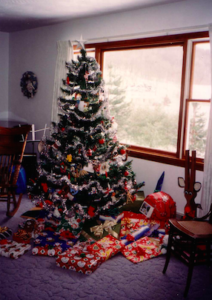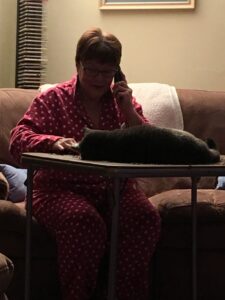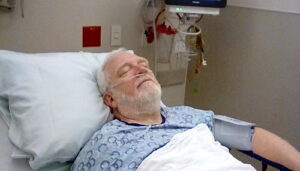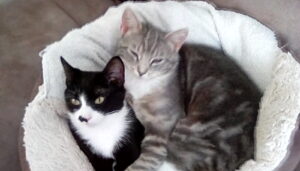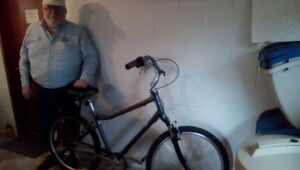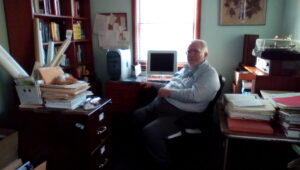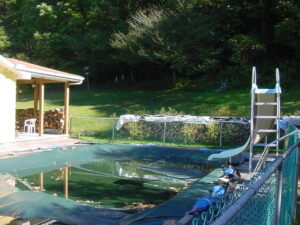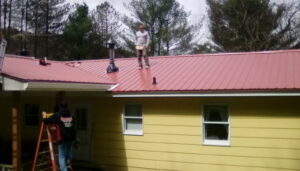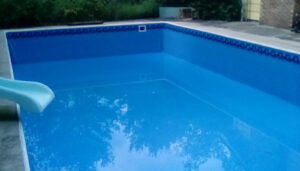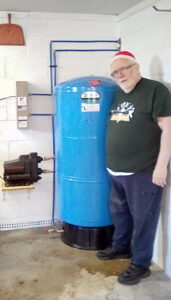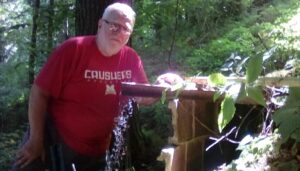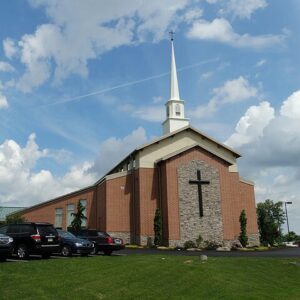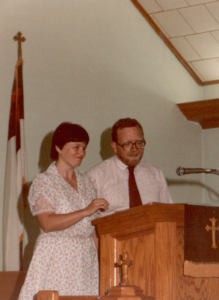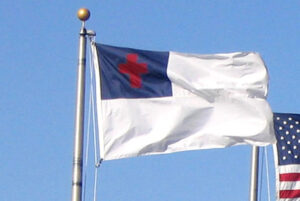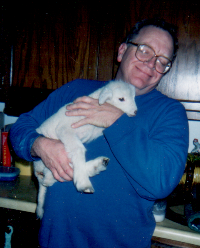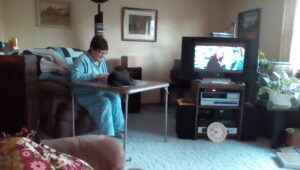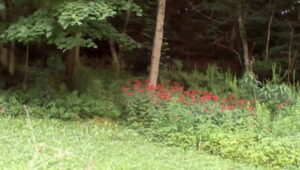by
Larry Pearce
4/30/22
Chapter 3D, Section v – Retirement so Far (2012 – 2022)
Holidays here at the ranch are just not the same without our parents. We lost Susan’s mother Hilda in 1997, what seemed like an eternity ago. The deaths of three of my close family members who were instrumental in the building of our home in Forwardstown were covered in the last installment: My dad Ralph, my mother Ruth, and my brother Carl “Butch.” I also described our life with Susan’s father Richard, “Dick” or “RO” to those of us close to him, but he passed away in 2015, in his 95th year, more than 17 years after his wife’s unexpected death. He had contributed cement, brick, and block technology in the construction of our bridge, our porches and sidewalks, and fireplace, not to mention the tools and encouragement. Sometimes I wonder how he had time to tend to his own work and home.
If Susan’s community activities increased after her mother died, they did so especially when our kids left home, as described in the last part. She reached even further into the community when her best friend Lucille passed in 2017. She had been Susan’s closest friend, voice teacher, and role model in all things music. As you’ll read below and in an upcoming installment on additional activities in our retirement, my bride and I took trips to Europe and continued our work in a new church and other local organizations after that time.
I even had a hip replaced and caught Covid, while trying to remain active. We celebrated a golden wedding anniversary in 2020, and hindsight tells me that we’ve always been best friends. Our recent journey has not been without turmoil, though. Last year I sold her car, leaving us with only a two-wheel drive pick-up truck to get around in. The back end of the 2007 all-wheel drive Mercury that we had purchased from the estate of my late sister-in-law Jean had come apart, and fixing it would have cost more than the car was worth. That happened before car prices went through the roof during the post-pandemic inflationary period. Needless to say, I regret having sold it now, and have promised to buy her a new vehicle shortly, mostly so we can transport her Christmas presents to daughter Annie’s for a visit this summer, two kitties. That’s the least I can do.
The Pandemic put an end to Susan’s private teaching as her music studio downstairs presented too close-a-quarters. We both realize that being away from “the music scene” for two years allows people to forget about us, not unlike when I quit playing the organ outside my own church on a regular basis and lost substitute jobs. After I retired from more active work in advertising sales and teaching, I surely have become lazy, limiting my investment work to mostly servicing existing accounts. Just the other day I complained to my broker that many of my older clients have either died or moved to Florida. Oh well, this gives me more time to research, write, and post to my family history website. I don’t mind riding my Polaris and John Deere either.
Speaking of riding, dear Susan gifted us each new bikes on the occasion of our 70th birthdays. We’ve ridden most of the trails in Somerset, Cambria, Fayette, and Westmoreland Counties. We’re working on Indiana and Butler Counties now. For some reason I can ride easier than walk after my operation. It’s getting off that kills me, well, not yet anyway!
After I retired from teaching at Mt. Aloysius College at the end of 2013, I followed the example of my dad and began downsizing in my share of our Forwardstown residence. Holed-up in my office, I sorted through shelves of books and boxes of media, old phonograph records and dozens of tapes. Most of the books I had used in teaching went back to the libraries at either Mt. Aloysius or the University of Pittsburgh at Johnstown. I was told that some would be shipped to developing countries overseas. That gave me a good feeling. The hardcover books dealing with music went to my undergraduate school, IUP. Recordings were given to the Johnstown-Cambria County library for sale to raise money. Again, I felt like I was giving back after all the time I had spent in those places. Perhaps best of all, I knew that if only a few of the promises I was offered by those institutions came true, keeping the objects from the landfill was worth the effort. I did try to organize the remaining media and have further plans to revisit the attempt when/if we move. Please understand that there isn’t a lot of time from November to May what with servicing financial clients, practicing music, and developing my family history web site. Of course, I’m mostly upkeeping our Forwardstown outside during the nicer weather. All of this I tell myself while watching TV news and snacking on the back porch. Seriously, I’ve fooled myself into an “I’m retired, so to heck with everything else” mindset.
If Susan and I have been motivated to save for retirement, it’s primarily because of the increased cost of living and the examples of aging gracefully our parents have set. Our plans are now to sell our Forwardstown estate and move to a local retirement village. That will cost money. So, as long as I’m able, I will continue to process wood for heating in the winters and live practically. As our mobility seems to have decreased with the years, my John Deere and my Polaris with all the attachments and tools is making the hard stuff easier. Several years ago, after crossing the 70-year boundary and having my hip replaced, I realized that I’d better start making plans, if not for me than for Susan without me. We met with our beautiful attorney Lauren and revised our wills. Furthermore, I established three main goals before I sold the house: replace the roof, install a new swimming pool liner, and rebuild our spring water system. As of this writing, two of the three have been fully accomplished, and after some preliminary work, we are preparing to finish the third this summer.
Surely the most important item in safe country living, especially when one wants to sell his house sometime down the road, so to speak, is an adequate water supply. I’ll get to that in a moment, but the other item is a roof that doesn’t leak. As I said earlier, the original asphalt one was installed when the house was built in 1975, with a similar one laid over the first around 25 years later. In order not to have to tear off those two covers for the recommended installation of a third, we were told that a metal roof placed over the last one was OK, as long as that one before was sound, with no shingles badly worn or blown off. We met that criterion. In the pre-Pandemic year of 2020, I had checked with several local contractors and was informed of how “backed-up” they were with work. We were fortunate to have Keystate Roofing, a local supplier of metal roofing materials in Somerset, owned by a reputable Mennonite family, so supply wasn’t the problem at that time. I told the story earlier of Susan and I eating lunch in the local Dairy Queen when I saw a young man who looked familiar. In asking of his identity, he reminded me that he had been in one of my English classes at Mt. Aloysius, and that he had formed a construction company that installed metal roofs. I asked him to come have a look at our house and make an estimate, which he did. His name is Dustin Shockey and he’s a busy family man with two kids. Despite the thought of having someone with a last name like his on a metal roof, I accepted his bid, picked out the color, and scheduled the job, one of his first of the new construction season as it turned out. Along with nailing down the new roof and replacing the soffit and fascia, he sub-contracted new gutters and downspouts. Those were formed and cut right out of the back of a truck on the property. Susan and I enjoyed watching the installations from lawn chairs out in the yard. We took lots of pictures.
The second major home fix-up job happened the next year at the end of summer. After several years of shopping for a new swimming pool liner, and hearing the same story over and over again about how long the waiting list was, we were finally able to write a payment check to the same family-owned company that had installed the last replacement liner about 20 years earlier. I remember the firm’s older namesake, Jerry Gilkey from just off Rt. 219, near Ebensburg, and how he carefully instructed his son and other workers in smoothing out the sandy base, unfolding the 18 X 36-foot vinyl liner into place, sucking the air out from behind with a vacuum motor, and adding water. The only difference this time was that the son had taken over the business, with “Dad” just an adviser and extra hand. The whole process took most of a day with them returning to pick-up some of the tools and checking the installation. This was the end of the season 2021, so we didn’t get much swimming in until we had to cover it for the winter. I’ll be anxious to rake the leaves off the top, remove the tadpoles, and siphon the water off from the cover before removing it, adding chemicals to the water, and diving in sometime after Memorial Day. I have always loved swimming, from the time I dammed up the creek near Cooperstown as a kid. My SCUBA club days at the Johnstown YMCA formed many fond memories, from trips to “the Coin Pile” just above Niagara Falls to the old stone quarry near Bedford, where I could look face-to-face at the most beautiful fish at 30 feet below the surface of the pristine lake. Unfortunately, I’ve always had ear problems and quit using the diving board here at home shortly after we installed the new swimming hole. Now I mostly walk laps around the shallow end. Sometimes I do it with so much gusto that I’m afraid of being sucked into the giant whirlpool I form.
The third and, hopefully, final major home improvement was started in March of this year. Susan’s cousin Paul, a plumber and engineer, designed and had his small Johnstown company install the first phase of a new water system for the house. As I said earlier, with the construction of our home in 1975, we had been drawing the liquid of life from a small spring just above our residence. It had also supplied water to the old farmhouse across the road for nearly a century, until the new residents hooked-up to public water. Although I had cleaned it out and replaced the walls and roof just before laying the line to our house, the walls fell and the roof caved in, presumably from age, just a few years ago. We had only used it as a back-up since discovering that it didn’t provide adequate pressure to our main floor and a second, larger cistern was available above it that met all of our needs. As I said earlier, that water silo also is quite old and has suffered some collapsing recently. I have temporarily replaced some of the walls, tied up the roofs, and covered both with tarps until major renovations can be made. That’s something Susan’s dad would have tackled in his younger days. Now, I may be able to find a local, sturdy German Brethren with that experience. They are coming up from Lancaster County, buying up the Somerset County farms, and doing what it takes to live the simple life.
Meanwhile, that first phase of water improvement mentioned above is complete: a 120-gallon stainless steel tank with pump and ultra-violet light for purification, in the garage, adjacent to the inlet lines and filter on the other side of the wall in the laundry room. That will provide a relatively inexpensive, yet reliable, holding tank after I build a simple by-pass line around the upper cistern for use while that big cistern is remodeled. It will also provide enough pressure for our main floor when it’s necessary to use the lower spring.
One of the best things Susan and I discovered this decade was the worship and fellowship of St. Paul’s Presbyterian Church in Somerset. As you have read, I was raised under the Calvinistic teachings that it is God who calls us into eternal salvation. There is nothing we can do but accept His invitation. Sometimes that urging is strong and obvious and sometimes it comes in the form of a gentle nudge. Our faith journey has been long and somewhat circuitous. As we described in the Jerome installment, Susan and I joined the Jennerstown United Methodist, following her parents in the early 70s and raised our kids there through junior high. Then we answered a calling to play the organ and sing in Johnstown, giving Annie and Matthew the opportunity to grow with other senior high young people. As they left home, we served in church music at other houses of worship around the City. By the later 90s, ready to rest awhile, we went back to Jennerstown to be with ole friends and serve en gratis.
But, in the second decade of 2000, I believe the Holy Spirit was calling us to a very old and larger congregation. Founded in the late 18th century, St. Paul’s now serves God and the community from a new building, its third location in Somerset. For me, it all began when I attended a Sunday School class there covering the teachings of Reformed Theology in general and John Calvin specifically, taught by a retired University of Pittsburgh professor. Our church, I believe, encourages a three-point hierarchy: God, others, and lastly ourselves. I was hooked and soon Susan, who had remained behind to direct the Jennerstown choir, followed. I began to play the organ once a month and she to offer solos in church periodically. We both joined the choir and other regular activities. Our circle of friends increased and we continue to grow spiritually there.
With all the positive things happening in this decade, I hesitate to mention the negatives. Some are obvious: The war in Ukrainia, the world-wide Covid Pandemic, and the political divisions in our country. There isn’t much we can do about the first, except contribute to relief efforts, which we do. The story of my contracting Covid while Susan hasn’t (yet?), is an interesting one. I’ll let you read about our bike ride that began on the Great Allegheny Passage and ended in the Somerset Hospital ER. Now, after being fully vaccinated and boosted, we feel protected, although some occasional symptoms, like nausea and blurred vision, make me wonder if I am a “long-hauler.” The disease seems to have reached an endemic stage in this country but continues to change with each newscast, not unlike the war in Ukraine.
As for our country’s and neighborhood’s political divisions, all one has to do is drive around Somerset County to see the often times nasty signs advocating our ex-president. While most of our parents and grandparents were what I call “rural Republicans,” that is old-fashioned, more conservative thinkers and voters, my wife and I have found ourselves more towards the middle, more generous and loving when it comes to opportunities for all. Where once our home, back porch, and swimming pool were open to all, we’re now afraid that such an invitation might lead to unkind words and strife, which we prefer to avoid. I did, however, reach the point last year when I wanted to respond to my neighbors, one of whom still flies a Trump flag in his front yard, believing that the 2020 election was “stolen.” I ordered a Christian flag online and raised it high in our front pasture, a silent rebuke to that nonsense. Now our like-minded friends and relatives number only a few. I even find myself somewhere between the politics of my brother and my sister. Oh well, it takes all kinds, they say.
Most recently, I experienced the worst example of the modern electronic age when our cable company changed hands and I was asked to “sign in” to their e-mail service to register my address. It all looked and sounded reasonable, so I did. Well, the next thing I knew, I was getting mail and texts from around the country from folks in my address book asking for specifics on what my problem was. Apparently they had received a request for gift cards to offer as a gift to our relative. It was an obvious “hack”, a hoax of proportions I had yet to realize. The criminals had taken over my decades-old e-mail service, shutting me out of dozens of personal addresses and thousands of important communiques. I talked to many cable representatives on the phone, but they couldn’t be convinced of what happened and who I really was. Fortunately, I had a dependable G-mail address, through which I informed those trying to contact me of the problem. It was so bad at one point that Susan recorded a new voice mail message explaining the situation. We have since given up on trying restore that old cable mail.
But wait, there’s more! Even worse than losing the e-mail address was losing this family history website, E-gen.info, for which I pay for the domain name and management. That old e-mail address was the foundation for reaching my edit page. At this point I had to be careful not to contact that address and risk them convincing GoDaddy, the management company, that they were I, but I couldn’t convince the many persons representing GoDaddy that I was whom I said I was and that I wanted to institute a new basic e-mail address. By the way, the address is used to change passwords, which is necessary and wise at times. They asked me to send them a picture of my driver’s license as proof of identity, which I did. The problem was, and is, that Susan and I don’t have a fancy iPhone to take such a picture. I tried a second time with the phone of a friend at church. This time, they claimed that my license was expired, which it wasn’t. Again, they just couldn’t read it. OK, so Susan tried a third time with her tiny laptop of me holding my passport next to my face. Success! After a month, this paying customer was granted access to his 20-year old website. I should explain that this site contains thousands of pages of family history, research, written up, and posted, but not always backed up and printed, something that I now working on. As I directed in our estate plan, developed several years ago, Susan and I have six libraries and history centers in Western Pennsylvania and Maryland that are to receive the appropriate writings after I pass. I hope never to have to go through a “hacking” again, and I realize that GoDaddy was doing exactly what I am paying them to do – to protect my property. By the way, the change of address affected Susan and my bank accounts, credit cards, and other holdings that have such an address on file. Consider that and register a back-up address.
Our back-up electric heat and powerful cable service that provides telephone, ROKU television, and internet are not the only wires we have contended with over the years. Our entire 18 acres was surrounded by an electric fence when we decided to to buy and build back in 1973. Neighbor and farmer Bob had old locust posts sunk into the ground from roadside to hillside and over the creek in both directions. When the ground was too wet or too hard to handle a post, he nailed an insulator to the nearest tree. The fencer wire ran up and down two telephone poles out along the road and across the pasture into Tom’s barn. When construction of the driveway and bridge started in 1974, Bob moved his cows home and we cut the fence in front just enough to get the building materials and equipment in. After we moved into the house in 1975, we considered the types of animals we would have, where the small barn would go, and then added fencing from the road, up along the driveway, and around what would be our yard and barn. I used mostly 48-inch steel posts and 14-guage wire that came on spools holding up to a 1/2 mile. Over the years I’ve tried aluminum, galvanized, and poly wire, that is synthetic braids wrapped in smaller metal wire, but while steel will rust, it is generally stronger and lasts longer. Of course in the 25 years we had sheep, we tried to replace the 4 strands of wire with 36-inch steel mesh fencing as we could afford. It’s more dependable, unless a tree falls on it.
Once the barn was in place, I dug a ditch from the garage down beside the driveway and laid both a PVC water pipe and 14-guage underground electrical service. I remember that my dad said that I should have used a larger wire in case I ever wanted to weld in the barn. That was over 40 years ago, and I haven’t done any welding yet and the service has stood the test of an electric fencer, lighting, and even an electric chain saw. My attitude is, “If the next owner wants to weld, he can dig his own ditch and lay his own bigger wire.”
Our first large animal was a $50 pony that the owner didn’t want anymore. We named him “Half-pint” because he was a small pinto, black, brown, and white. He was very spirited and wouldn’t cross the bridge with a grated deck over the creek below our property, so I led him down the bank, into the water, and up the other side. He spent the first winter in a small tool shed across the road on a neighbors property. It was there that our vet castrated him. Neither of us like that, but that was part of trying to tame his high-spiritedness, which he never really lost. Once Susan went into the fence to pet him, and he reared up, striking her on the bridge of her nose. I was at work. She immediately fell to the grass and rolled under the fence, where our neighbor, Tom’s mother, took her into her house and bandaged the wound. Another time, when we put several young steers in with him, he chased them until they got stuck under the driveway bridge. I had to remove him from the pasture to get the calves out.
Half-pint brought us several years of pleasure. We would stake him in the back yard during picnics for the kids to watch. I borrowed a two-wheeled cart to have him pull me through the streets of Jennerstown for their Fall Festival. Of course, I gave as many free rides as daylight would allow. We had an older gentleman from Johnstown stop out along the road and feed him day-old bread scraps almost every day. Unfortunately, we had a very warm December one year and Half-pint over-ate the lush grass and suffered “laminits,” or foundering, a condition from which most animals never recover. His front hoofs turned up, giving him great pain, discouraging him from walking. The vet trimmed the hooves back as far as possible and we gave him pain medicine and stood him in the cold waters of our creek, but he never recovered. When I couldn’t convince anyone to “put him down” before winter set it, I put him on a truck going to auction. I hate to think that he might have gone to an animal food market, but I guess they have to eat too. My lesson was not to let animals suffer, and later when we had sheep, I unfortunately had to put several of my beloved animals down. Fortunately, I had built up the courage to do that. I also had to bury them. The saddest days of our years of having sheep was coming home from the slaughter house after selling lambs for meat, knowing what fate awaited them. I’m glad I didn’t have to make a living raising livestock. I don’t think I ever made a profit from any of our animals. They gave us great pleasure, and I hope that their time with us was also pleasurable.
Though we had a small barn with lots of hay, and feed at the appropriate times, our sheep liked to be outside, as do most animals, I guess. A sheep’s gestation time is about five months or 152 days. One thing is certain, the prospective mothers would lie as far away from the barn as possible when the time came to deliver. I always kept one ram to “service” the gals, but I had no way of knowing when they were due since my operation was natural, as opposed to “artificial.” I do know that first-time deliveries were usually singles, as opposed to twins for healthy, experienced ewes. Most ranchers sold their ewes after about five years because older ewes could have triplets, which seldom survive because of their smaller size. I learned that the hard way when one of my favorite, older ewes had triplets. Another time, I failed to find a baby out in the field and thought her mother, crying at the top of her lungs, hadn’t delivered yet. I herded her into the barn for examination, but found nothing inside. In returning to the pasture, I found an otherwise healthy lamb drowned in the creek. That was a sad day. On a happier note, Susan, the kids, and I came home from a late Christmas Eve service to find a newly-delivered lamb frozen. The protocol is to bring them into the house, wipe them with warm water, give them mouth-to-mouth if necessary, and use a medicine dropper to give them warm milk. I tried everything, to no avail. Discouraged, I left her by the wood burner before going to bed. Sometime in the middle of the night we heard “clippity clop” on the kitchen floor and loud “Baahing.” The little girl was alive. Halleluiah. We were all awake now to give her a full measure of formula. We named her “Holly.” She wore a diaper and lived in a large box that our new washer came in. When the coldest weather subsided, we took her and the box to the barn with an electric light bulb, an arrangement similar to raising chicks. Of course her mother had rejected her by then, so fully mixing her with the flock would have been unwise. As the days got warmer and Holly started to munch on grass, we took her to the pasture to release her. Going into the fence, she looked back and forth between the others and us, and finally went with the flock. Of course we supplemented her diet and kept watch over her. She not only thrived but delivered a number of healthy lambs herself over the years. Unfortunately, as did some of the others, she developed listlessness, a type of Wasting Disease, which was terminal, and I chose to put her down myself rather than call the vet. I was told early on that, “By the time you call the vet, it’s usually too late.” I don’t regret that decision.
Though I grew up with a wonderful dog, Tiny, in Cooperstown, our family never owned a canine after she died. After son Matthew finished his graduate degree and moved to 70-degree, year-round Colombia, South America, to start a language business, he “inherited” a gorgeous cocker spaniel named Paco. The family who had the young dog could no longer afford to keep him, and Matt had been smitten after socializing with the family. When the business could no longer sustain itself, Matt’s work Visa ran out an he had to return to America. Paco was in for the ride of his life: in a heated, pressurized compartment in the belly of a large jetliner bound for a wintry Pittsburgh. His first taste of the season was during a lay-over in New York, outside on the tarmac while Matthew watched out the window, worried sick. All turned out well, as the two boys were picked up in Moon Township and shuttled halfway to Forwardstown by my sister Ellen. It wasn’t any warmer in New Alexandria, where we met, nor when we got to their new home in the Laurel Mountains. But both got accustomed to the colder weather quickly as I took Paco on his twice-daily walks, and Matt found work and commuted to Altoona and eventually settled alone in New York City. With that we’d often all spend part of weekends together in between near the Harrisburg stop of the Pennsylvania Railroad. Before long, Matt went to work for Allstate Insurance, writing computer code in Charlotte and able to take Paco back. The two lived comfortably, taking walks in the temperate climate there, until the pup got sick with cancer. Despite the heroic efforts by both man and pet, Paco eventually passed peacefully, leaving Matthew with a broken heart. After the Pandemic hit, Matt was allowed to work from Colombia and able to take his wonderful memories of a great friend with him.
Cats have always been the small animal of choice for Susan and me, and we’ve had a total of seven of them, but not all at once, thankfully. Growing up, our parents always had cats on their farms. Seldom were they allowed in the house in those days, but they caught mice in the barn and were close by during the milking, begging for a dish of that white liquid. Maybe that’s why our first kittie, Mitzy, had to stay in the basement her first few nights here. She had come from a neighbor in the spring after we moved in. It didn’t take long for this tabby to win our hearts and move upstairs with us. She lived for 13 years. The kids brought me another tabby, Edward, as a birthday present from the neighborhood near our church in Johnstown before Matthew went to Germany as an exchange student in 1989. At first we named him “Edna” after my beloved aunt, thinking he was a female. During his first trip to the vet, we were told to be prepared for an active time because he was a male. We changed his name to “Edward.” I remember that, as a young man, he used to walk along the top of the pool fence as if it were a tightrope. While Eddie was still alive, I found a beautiful, black cat, Keenya, a take-off of the African country, making a “nest” in the barn hay. She was fat, and I thought she must be pregnant. At the time, we weren’t prepared for the thought of more than one cat, so we advertised to find her owner, thinking that she had wondered off to have her kittens. No response. So to the vet she went for a hysterectomy. Turned out, her plumpness was worms, and by this time we had fallen in love with her, and decided to keep her. Like Edward, she too was a “climber,” often resting atop the wood stacked on the back porch in the sunlight. She was the dearest, gentlest creature, and unlike all the other of our cats, wondered off to die in the woods after a long life. The rest are buried just above our utility pole between the house and the barn.
With Mitzy gone and Edward and Keenya getting older, we had a visitor one Sunday afternoon. How do I remember that? Well, I was up on the roof adjusting the TV antenna so we could get the Steelers game. I heard loud meowing from the woodsline. I looked up to see a tiny gray kitten navigating the autumn leaves toward the house. I later learned that she was either a British or Russian blue, a breed with a wonderful history and disposition. I immediately climbed down off the roof, scooped her up, and took her inside to a napping Susan. She was still “singing” at the top of her lungs, so we called her “Figaro.” I know, that’s a boy’s name, but didn’t know her gender at the time and the name seemed to fit. We offered the baby girl a dish of milk and she lapped it up as though she was starved. I often wonder what happened to her mother, but I didn’t want to leave her outside to die. She made a wonderful, loving pet and lived a long life.
An even better story came with another gray kitten we called “Chiapet,” or “Chia” for short. One winter’s day I was feeding the sheep in the barn and heard a meowing in the loft. I knew that could only mean a kitten up there. I ambled up to the house and came back down with a saucer of milk and placed it atop the ladder to the loft. The next day I heard and did the same thing. On the third day I went up with another dish and was able to lure her into my arms. However, backing down the ladder with her, I slipped, fell backwards onto some tires, and she got away – back upstairs. Less than slightly injured, I was determined to “save” this barn kittie who had possibly been abandoned by her mother in the middle of winter. Repeating my luring technique the next day, I was successful and more careful backing down the ladder. Susan and I had set up a “nursery” in the back bedroom with litter box, bed, and feeding station. Chia hid under the dresser for a week, and we allowed her space to get accustomed to indoor living. She eventually warmed up to me, even sleeping on my chest. That was a picture I used on my e-mail account for years. A rather shy feline, it took her months to allow Susan to hold her. She lived well into her teens and was the latest to be buried above the pole with her “sisters and brother.” With her passing, the Covid outbreak, and Susan and I contemplating a change of locations, we went without a cat for almost a year and a half. Finally, knowing that we could have pets at our retirement village when/if we move, we adopted babies Oreo, a tuxedo, and Mary, another tabby. I’ve gotten more exercise than I’ve had in quite a while since we’ve had them: up and down to scoop two litter boxes, pulling a string-on-a-stick around the house, and bending over to pick them up for vet visits and regular loving. I think we’ll keep them ;>)
Our house and property have always been filled with flowers – inside and out. I guess I got the habit from my mother. While Susan mostly “tolerates” my hobby, her mother was a plant connoisseur as well. I have several colors of violets, prayer plants, ferns, snake plants, and palms, to name a few. I water them no more than once a week, but that’s not easy now that we have two cats. First we had to cover most of the soil in the pots with aluminum foil because these guys were raised as outdoor kitties and learned to “go” in the ground. Not only that, they love to eat most of the leaves. So, when I water, I have to make sure that they’re asleep, and even then, they hear me and follow me around, sticking their heads under the stream of water. I close the door to the room I’m watering in or just put the watering can down until later. I try not to pick them up and throw them somewhere.
Outside are dozens of species of flowers and plants, not to mention the trees. I’m delighted
at the new Green Earth Movement that encourages people to forget the manufactured fertilizers and lawn mowing so far from the house. Our daughter Annie teaches and encourages such “sustainability” at Virginia Tech. We encourage each other to keep “Going Green.” The wonderful thing to me is that “To everything there is a season.” We have a continuous outpouring of beautiful vegetation on our land in Forwardstown, from the crocus in early spring to the Indian Paint Brushes in August to, of course, the abundance of autumn leaves. The bees and the butterflies appreciate them more than we do, I’m sure. And oh, by the way, we can tell the time of the year, almost to the day, by the arrival of certain birds, which I talked about before: the robins in March, the barn swallows in April, the humming birds in May, and the orioles in June – their first nest, that is. After teaching their fledglings to fly, they go farther north for a second nest, then stop back in Forwardstown in the fall on their way south for the winter to say goodbye. Read more about God and nature in our “Ten Short Meditations.”
Well, that’s enough for now about the past ten years here. Even as I outline and write this Memoir, I continue to recall even more. Although I move now to sections dealing with specifics in my careers, missions and ministries, and additional retirement activities, I will no doubt want to share memories that come after I’ve posted these installments. I want to write addendums to each topic and include additional pictures and media, so please check back, especially since I consider this early edition a draft.
Move to: Chapter 4 – Interlude to My Life’s Work
Return to: Table of Contents
Last revised 5/6/22

